24 Hour Research (Written on Jan, 11, 2014)
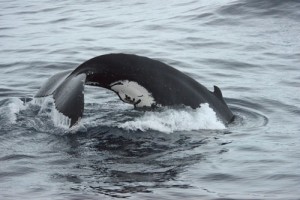
A huge peduncle arch and fluke up dive – this whale is “playing in the chocolate milk”!
Photo credit M. Jenner
At the end of each day we have noticed around 9pm through until 1030, any encountered humpback whales become very Surface Active, surging and rolling as they lunge-feed through the swarms of krill. Open-mouthed, they surge through the water surface in a dorsal or normal orientation. Some of the whales twist their bodies sideways and others surface with their bellies uppermost, extended ventral throat grooves easily visible. Humpback whales have a flat, plate-like upper jaw with approximately 365 carotin-like baleen plates hanging vertically into their bucket-shaped, lower jaw. Extending the jaws and scooping huge amounts of water and krill into the lower jaw, water is pushed out of the mouth as the upper jaw closes, thereby filtering the krill through the baleen plates. Water gushes out and around the sides of the mouth and the two tonne tongue then comes forward scooping the krill into a food bolus and moving it towards the oesophagus, the size of an orange. Several whales at a time, surge through the water with different feeding styles, it’s all go! A wonderful sight to see! In the twilight, increasing the ISO on the camera, clear photos captured their antics. Four pods of whales were sighted between 12 and 6am this morning, three humpback whales pods (5 animals) and one fin whale cow/calf. This is an awesome place, you can physically see all night long and the whales are particularly active, all night long!
All of this action starts happening just when most of the crew are going to bed, excepting Simon and Resty, whom are on watch from 9-12. Visually observing cetaceans gives useful data, but in the last ten or so years, satellite telemetry has yielded much more. Even recently, satellite telemetry instruments, and in particular Russ’s tags, now include dive profile information as well as the location of the fixes and thus the location of the animal. The tags on “Round” and “Wobble” are dutifully collecting data while we sleep! We are in 24 hour research heaven!
All morning we were on iceberg patrol while looking for whales. The visibility with the fog varies between 100-180 m. Four pairs of eyes are peeled, two on the fly-bridge and two in the wheelhouse. We scanned for growlers and bergy bits that appeared out of the gloom, some to port others to starboard. “Iceberg at 2 o’clock, we are ok”, I radioed down to the wheelhouse. We had settled on very simple communication regarding these sightings, which is standard safe practice to avoid confusion. The only bird seen on bird obs (observations) was a brave little fitting Black-bellied storm petrel and sadly throughout the day, no animals were seen since 6am. After my visual obs watches from 9-11, I stayed fully dressed until 1120, ready for the 1115 whales we have had the last few days, but they didn’t show.
Light snow tried to fall, but only a few snowflakes were seen. The air moisture must increase and the temperature drop, perhaps later. “This is an announcement -your lunch is ready, this is your chef!” In a funny accent, Restys’ voice boomed throughout the vessel on the internal intercom PA system. The first time he did this a few days ago, I thought there was another boat nearby, as it seemed as if it was coming from the radio! With the lunch call we flocked to the warm, main saloon and were treated to hot pumpkin soup, warmed baguette and Restys’ special fried rice and sweet fresh pineapple! The taste of sunshine felt very luxurious, way down here!
Noon Observations Jan 11, 2014
Lat/Long: 640 18.4 S 1320 08.7E
Dry Bulb Temp: 1.20C
Wet Bulb Temp: 0.80C
SST (Sea Surface Temp): -0.20C
COG (Course Over the Ground): 2530
SOG (Speed Over the Ground): 5.2 knots
Barometer: 988 Hp
Beaufort SS (Sea State): 0
WS (Wind Speed): 1-3 knots, fog
WD (Wind Direction): NW
Swell: SW NW 2 m
Wildlife: Southern Fulmar, Black-bellied storm petrel and 5 humpback whale pods (9 animals) and cow/calf fin whales.
WT: TNWPN – 6.5
Antarctic Fact: The highest recorded wind speed in Antarctica was 327 km/h in 1972 at the French station Dumont d’Urville.
Antarctic Slang: slushy (Australian) station kitchen hand, a rotating duty.
Twelve icebergs show as red targets on the RADAR within 12 nm – this is indeed iceberg country, although not as concentrated as they can be. The 1230 sonobuoy deployment was a cocktail of sounds – seals shrieking, humpback whales trilling, sperm whales clicking and racheting, killer whales singing and icebergs grumbling. The sperm whales calls were fascinating, you could hear three ‘shots’, three attempts to stun and kill squid for consumption. “Sounds like the wild west out here!” commented Curt, while he and Rob monitored two computers, SONIX and PASOR comparing bearings on the different software and recording the characteristics of each calls heard. Getting closer to the ice edge and heading westward, we anticipate that we will find more whales. A possible blue whale call in low frequencies lifted our hopes tremendously! We are anxious to find some blue whales and always remain hopeful.
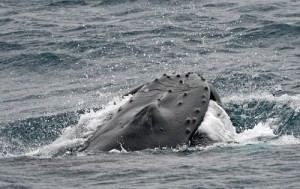
Surfacing through the krill, water gushes from the mouth as the baleen plates filter the 6cm long macroplankton.
Photo credit M. Jenner
All of our travel for the next few days is towards the west and interestingly, in the last 24 hour period (0600 to 0600) if we were crossing Bass Strait we would have covered 215 nm, but as we are at high latitudes, in fact, we only travelled 100 nm for the equivalent longitude readings. Ouiou! We have experienced Whale Song Time Travel! This place is SO cool!
Speaking of locations, currently (2000, 8pm) we are passing westward from Wilkes Coast to the Banzare Coast, passing Cape Mose, inland of which is Porpoise Bay. This bay is bordered by Cape Goodenough, all of which is Australian Antarctic Territory. We have nicely managed to escape the throws of that massive low-pressure system that dominated the region for the last week. We have found a new way home from the east in summer, duck down below everything and skirt the ice edge, fantastic!
Antarctica is the coldest, the driest and the windiest continent on our planet. The Southern Ocean, the waters surrounding the Antarctic continent, are cool and nutrient-rich, fuelling this complex ecosystem. Macroplankton (2-20cm long) includes large visible organisms such as krill, along with arrowworms, combjellies and jellyfish. These, shrimplike or elongate zooplankton encompass commercial crustacea such as prawns, shrimps, lobsters, hermit crabs and crabs. Antarctic krill (Euphausia superba), the basis of the Antarctic food chain, is a 6 cm planktonic crustacean that is found in huge swarms below the Antarctic Convergence. Typically found in night-time tows, krill may have bioluminescent dots along each segment of their abdomen, possess stalked eyes, a loosely fitting carapace around the abdomen and have long, setose limbs. There is also a smaller species, the ice krill, (E. crystallarophias). Phytoplankton (small plants) bloom and in turn, zooplankton feed and flourish. Antarctic krill form the basis of the Antarctic ecosystem, eaten by baleen whales (blue, fin, sei, humpback, minke), many species of southern seabirds (including penguins), squid, fish, and also crab-eater seals, whom have developed specially adapted teeth for this purpose. In our Bio Sonics data collected last night, a swarm of krill was over 2 nm long!
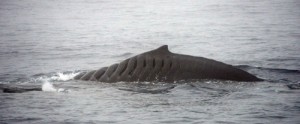
A ship strike injury on this humpback whale left 21 scars, remarkably it survived.
Photo credit M. Jenner
At 1437 snow fell very gently, without conviction. Dinner was served and we were very happy with Restys’ bacon pasta sauce and mountains of spaghetti for the hungry troops! Just after dinner, Curt sighted a humpback on the bow. I quickly dressed in my warm outside gear, (I am getting very fast at putting on all these layers), and on deck in the closing fog we saw two humpback whales. As I took left lateral body photos of the larger adult I could see up to 13 deep propeller scars extending the whole side of the whale… how did this animal survive? We only saw two surfacings as they disappeared into the fog. I thought it would be reasonable to believe that this whale would be weary of vessels, having been injured so badly. Even the edges of the tail flukes did not escape – three slices made the fluke wobble freely.
As we continue west we are slowly approaching the ice edge again in the hope of more whales and clear skies,
Mich




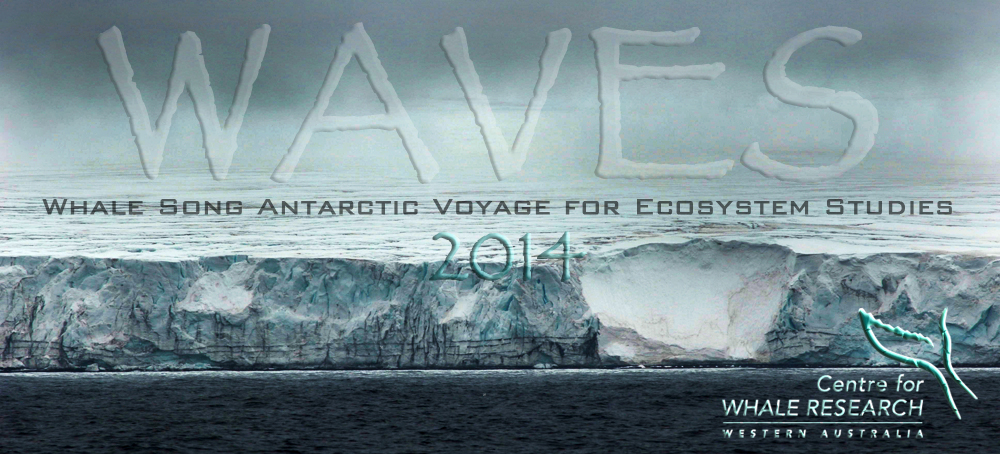










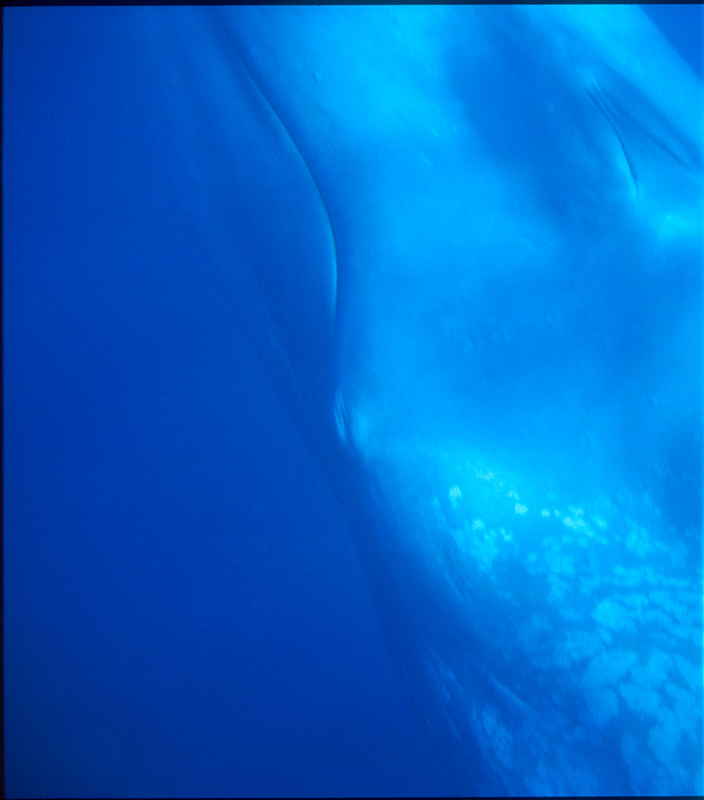
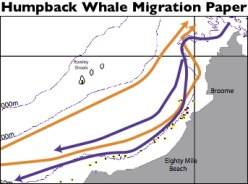
No comments yet.